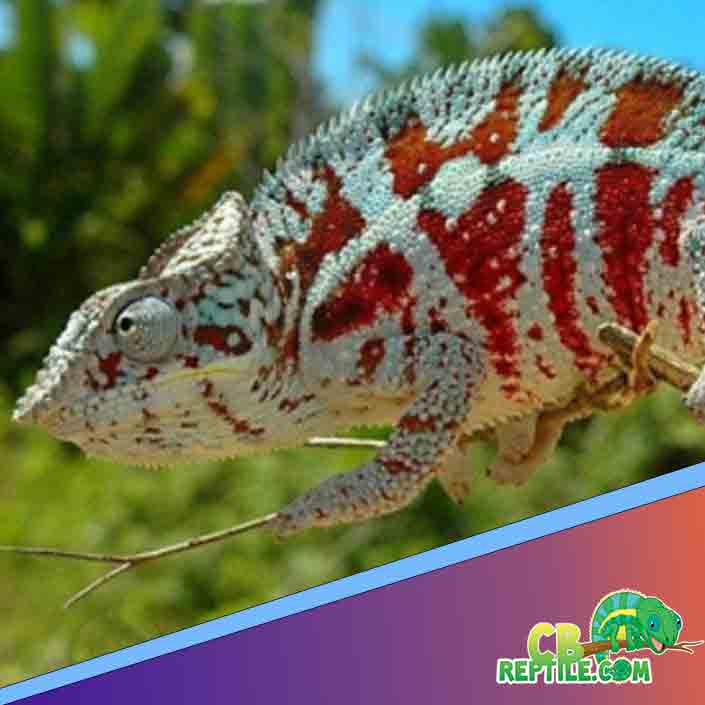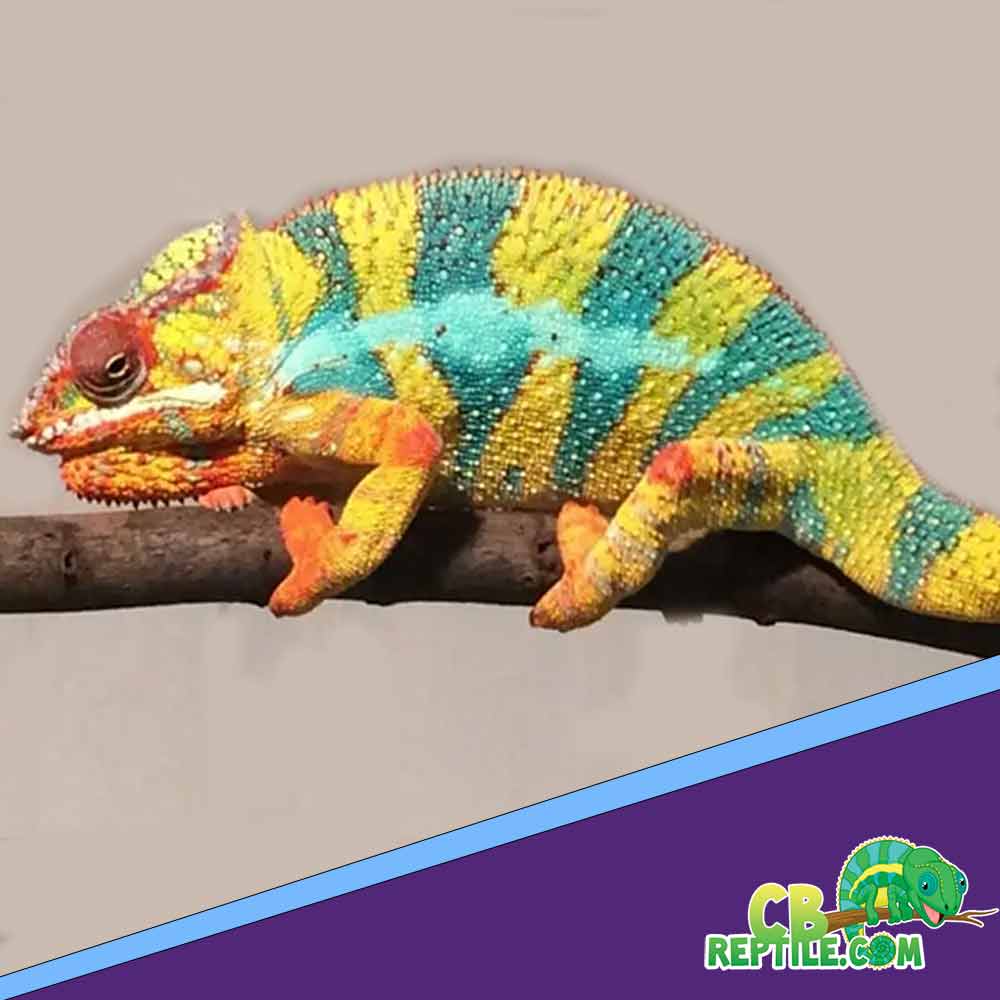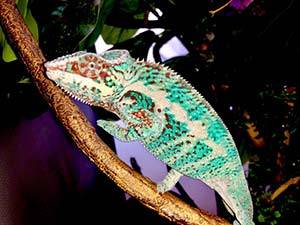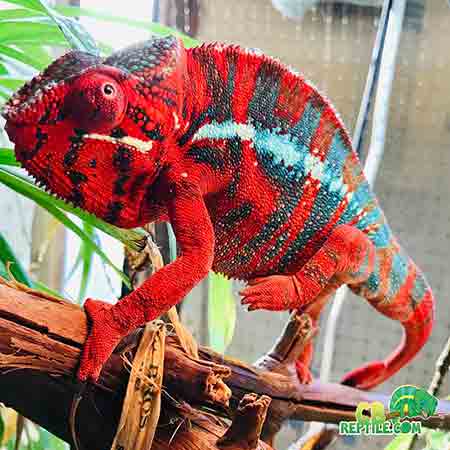Panther Chameleon Enclosure Setup & Environmental Controls
Creating the ideal enclosure for a panther chameleon is one of the most important parts of successful husbandry. These animals are highly sensitive to their surroundings, and a properly designed setup can dramatically improve their long-term health, hydration, coloration, and behavior. This guide breaks down every major component — enclosure size, ventilation, environmental control, branch structure, foliage placement, and more — providing a complete, modern blueprint for keepers of all experience levels.
Panther chameleons thrive when their environment mimics the vertical, airy, multi-layered habitats of coastal Madagascar. Purchasing a captive-bred chameleon from the best panther chameleon breeder gives you a strong foundation, but the enclosure you build will ultimately shape the animal’s quality of life. This page outlines how to construct the optimal space for your chameleon to explore, bask, hunt, and hydrate naturally.

Choosing the Right Enclosure Type
The first and most important decision you will make is selecting the proper enclosure type. Panther chameleons do best in tall, well-ventilated habitats with strong airflow and abundant climbing space. The debate between glass, screen, and hybrid enclosures continues within the reptile community, but each has clear pros and cons when used correctly.
Screen Enclosures
Screen cages are the gold standard for most chameleon keepers because they offer unmatched ventilation. Warm, humid air rises naturally and escapes through the screen, preventing bacterial buildup and keeping respiratory issues to a minimum. A typical adult enclosure should measure at least 24 inches wide, 24 inches deep, and 48 inches tall. Larger is always better, especially for active males.
Because screen enclosures allow humidity to escape quickly, environmental control is achieved through thoughtful misting, fogging, and plant placement. This guide covers those aspects below.
Hybrid Enclosures
Hybrid enclosures—those with a combination of solid sides and screen panels—are becoming more popular. They offer the best of both worlds: extra humidity retention without sacrificing airflow. These are ideal for keepers in very dry climates or during the winter months when indoor air becomes unusually arid.
Hybrid enclosures can reduce stress for shy individuals by providing more visual barriers while still allowing comfortable climbing temperature gradients.
Glass Enclosures
Glass terrariums are generally NOT recommended for beginners because they trap heat and humidity too effectively unless modified with additional ventilation. However, experienced keepers may use them under controlled conditions, especially when maintaining hydration for young hatchlings.
If you choose glass, ensure there is a large, screened top and multiple ventilation ports. Stagnant air is one of the fastest ways to create health problems in chameleons.

Creating a Natural Vertical Habitat
Panther chameleons are arboreal animals that spend nearly 100% of their lives above ground. A well-designed enclosure is built vertically, not horizontally. This means installing an interconnected network of branches, vines, and perches that run from bottom to top, allowing the animal to explore the full range of temperature gradients.
Adult males especially require sturdy branches capable of supporting their weight. Use natural wood, cleaned and dried hardwood branches, or commercially manufactured reptile vines.
Key structural components:
- Basking branch: positioned near the top directly under the UVB and heat lamp.
- Mid-level pathways: horizontal branches that allow thermoregulation.
- Dense hide zones: mid-to-lower foliage for rest and security.
- Vertical “highways”: diagonal vines enabling travel through different layers.
Your chameleon should never be forced to climb the screen itself for long periods — this can damage nails and create stress.
Plant Placement & Foliage Density
Plants serve several purposes: hydration, visual security, humidity support, and natural cover. A well-planted enclosure is always preferable to a sparse one, provided you maintain open basking lanes and safe climbing routes.
Best live plants include:
- Umbrella plants (Schefflera)
- Pothos vines
- Hibiscus
- Ficus trees
Artificial foliage can be used to supplement coverage, especially in areas where live plants cannot thrive under strong lighting. Place dense foliage in mid and lower sections, while leaving the upper sections open for UVB exposure.

Environmental Control: Temperature, Humidity & Airflow
Environmental control is the heart of panther chameleon husbandry. These reptiles rely on external sources for thermoregulation and hydration, meaning you must create gradients—not uniform conditions.
Basking Temperature
The basking area should reach 85–90°F for most adults. Females often prefer slightly cooler basking areas. Your basking branch MUST be placed at a safe distance below the heat lamp, and you should always monitor temps with an infrared thermometer.
Ambient Temperature
Middle and lower sections of the enclosure should rest between 72–78°F. This gradient allows the animal to self-regulate.
Nighttime Drop
Panther chameleons benefit from a moderate nightly temperature drop to 65–72°F, which mimics natural conditions and aids healthy rest.
Humidity Cycles
Humidity should not remain constant. Instead, the enclosure should cycle between high humidity after misting (70–90%) and lower daytime levels (40–60%) as the enclosure dries out. Cycling humidity prevents respiratory infections and creates natural drinking opportunities.

Drainage & Water Management
Misting is essential, but water must go somewhere. Standing water is dangerous, so drainage is a critical part of enclosure engineering. Many keepers use:
- Drainage tables
- False bottoms
- Bulkhead drains
- Absorbent mats beneath planters
Design your system to remove water automatically. The more water the enclosure receives (especially in hybrid setups), the more essential drainage becomes.
Why Good Enclosure Design Makes Such a Difference
A well-built enclosure supports immune function, prevents stress, reduces dehydration risk, and enhances color expression. When keepers purchase from experienced breeders with consistent husbandry systems, such as the best panther chameleon breeder, the animal arrives already adapted to proper environmental rhythms.
If you are still deciding where to buy chameleon that has been raised in ideal conditions, selecting a breeder that prioritizes the enclosure setup during rearing will give you an enormous advantage.
Starting with a vibrant, well-started juvenile and placing it into a properly designed enclosure is the single most powerful formula for long-term success.





